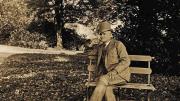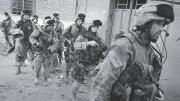Perhaps no American writer’s life has been front-loaded more drastically, or to better purpose, than that of Francis Parkman. Still the grandest and most ambitious of our historians, he built his life work, an epic saga of North America’s discovery, exploration, and settlement, on impressions and experiences gained within a matter of months before he turned 25.
Born into the topmost ranks of Bostonian society, Parkman was the son of a prominent Unitarian minister who set him on the conventional path to Harvard (Class of 1844, LL.B. ’46) in order that he be trained in a respectable profession, having observed that the young man showed signs of eccentricity. While still a boy, Parkman had become fascinated with nature. (He later served a year as professor of horticulture at Harvard.) He loved the life of the forest, and in particular the lives of the forest’s people—the American Indians.
During two summer vacations from college, Parkman and Harvard friends headed for the deep woods of northern New Hampshire and western Maine, camping, canoeing, bushwhacking, hunting, and living among woodsmen and Indians. In that near-wilderness, Parkman was not simply a tourist. As a college sophomore, he had formed a grand ambition: to write the history of the 200-year contest between France and England for dominance in North America, from the earliest voyages of Cartier and Champlain to the final defeat of the French at the Battle of Quebec in 1759. This work inspired and directed his entire life.
It was to further his long-range plan that Parkman embarked on his life’s great adventure. Needing firsthand knowledge of Indians and their lives, hardly to be had in the East any longer, the 22-year-old, and a cousin, took off in April 1846 for the West, following pioneer routes across the Great Plains in a journey of six months and about 2,000 miles. The climax of the trip was the roughly three-week period near Laramie, Wyoming, where Parkman lived, traveled, and hunted with a band of Oglala Sioux, people of a toughness, hardihood, and stoicism totally unexampled in his patrician milieu.
On returning to that milieu, Parkman found himself in need of all the toughness and stoicism he could muster. His health had long been uncertain. He suffered from insomnia and poor digestion, his eyesight sometimes failed for months on end, and an arthritic knee often confined him to a wheelchair. He was also the victim of obscure depressive symptoms, what he called a “whirl in the brain,” a nonspecific anxiety or agitation that made concerted mental work impossible. Back in Boston, he broke down completely. For nearly 20 years—essentially the middle of his life—he was a virtual invalid.
Even so, Parkman summoned the will and the patience to advance his work. Unable to write, he composed long passages of prose in his head and dictated them to secretaries. He used readers and copyists. He published The Oregon Trail, his famous account of his Western travels and always his best-known book, in 1849.
Through the 1850s and ’60s, sometimes slowly and painfully, he pushed ahead on his major work, France and England in North America, comprising eight separate books. He thought of it as “the history of the American forest.” When his health permitted, the tireless and super-meticulous researcher traveled to Canada, Florida, Paris (at least three times), and London to consult original documents. Reference materials for one volume ran to 6,000 pages.
More remarkable than his research, however, was the vitality and color of his writing. His history, for all its scholarship, is never dry. The major figures—the explorers Champlain and, especially, LaSalle; Frontenac, the royal governor of New France in Canada; Braddock, Howe, and Wolfe, the doomed British generals—are brought memorably to life, as are their settings: the dark Canadian wilderness, the vast grasslands of the Plains with their endless herds of buffalo, the Mississippi and Gulf of Mexico. Parkman had an ability unsurpassed among writers for putting the reader in the scene.
Nor was he only a painterly romantic. His passages of straight narrative and of analysis and exposition are invariably lucid and graceful. Much of their energy comes from a pervasive irony related to the contrast between the human actions described and the scale of the continent that is their stage. In LaSalle and the Discovery of the Great West, he tells of the explorer’s arrival at the mouth of the Mississippi River and his vainglorious proclamation that half North America was now, henceforth, and forever the property of Louis XIV:
On that day, the realm of France received on parchment a stupendous accession. The fertile plains of Texas; the vast basin of the Mississippi, from its frozen northern springs to the sultry borders of the Gulf; from the woody ridge of the Alleghenies to the bare peaks of the Rocky Mountains—a region of savannas and forests, sun-cracked deserts, and grassy prairies, watered by a thousand rivers, ranged by a thousand warlike tribes, passed beneath the scepter of the Sultan of Versailles; and all by virtue of a feeble human voice, inaudible at half a mile.
Parkman’s health improved in the 1870s and ’80s. He had been bringing out the main volumes of his history since 1865 and published the final one in 1892. At his death, he was recognized, according to one biographer, as “a great historian, the greatest perhaps who had ever appeared in the country.” Parkman, and his readers, might agree that those few months in the woods and on the prairies 50 years before had stood him in good stead.








